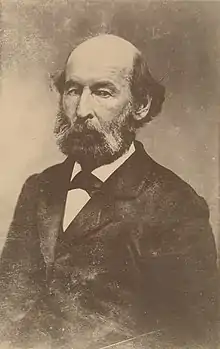Eli Thayer
Eli Thayer (June 11, 1819 – April 15, 1899) was a member of the United States House of Representatives from 1857 to 1861. He was born in Mendon, Massachusetts. He graduated from Worcester Academy in 1840, from Brown University in 1845, and in 1848 founded Oread Institute, a school for young women in Worcester, Massachusetts. He is buried at Hope Cemetery, Worcester.
Eli Thayer | |
|---|---|
 Eli Thayer | |
| Member of the U.S. House of Representatives from Massachusetts's 9th district | |
| In office March 4, 1857 – March 3, 1861 | |
| Preceded by | Alexander De Witt |
| Succeeded by | Goldsmith Bailey |
| Personal details | |
| Born | June 11, 1819 Mendon, Massachusetts |
| Died | April 15, 1899 (aged 79) Worcester, Massachusetts |
| Political party | Republican |
| Children | John A. Thayer, Clara Thayer (Mrs. Charles H. Perry M.D.), Ida M. Thayer.[1] |
| Alma mater | Worcester Academy, 1840; Brown University, 1845 |
He is chiefly remembered for his crusade to ensure that the Kansas Territory would enter into the United States as a free state. With this aim in view, early in 1854 Thayer organized the Massachusetts Emigrant Aid Company to send anti-slavery settlers to the Kansas Territory. In 1855, this organization joined with the New York Emigrant Aid Company and the name was changed to the New England Emigrant Aid Company. The motives of Thayer in establishing the New England Emigrant Aid Company were questioned by historian David S. Reynolds who wrote that Thayer "opposed slavery not on moral grounds but because [he] wanted to foster laissez-faire capitalism in the Territory"[2]
Local leagues were established whose members emigrated to Kansas and established towns. The Company provided hotels for temporary accommodation (such as the Free State Hotel in Lawrence) and provided sawmills and other improvements. Settlements were established at Manhattan, Lawrence, Topeka, and Osawatomie. The clash of these settlers and other "Free-Stater" Northerners with pro-slavery settlers spawned the violence of Bleeding Kansas.
Thayer wanted to establish an antislavery colony in Virginia, but land was too expensive. He then looked to western Virginia. Thayer chose to build his colony at the mouth of Twelvepole Creek in Wayne County, Virginia now West Virginia. He named his town Ceredo after the goddess Ceres. The town was founded in 1857. He enlisted fellow abolitionist Zopher D. Ramsdell to settle there and establish a boot and shoe factory.[3] It is open as a historic house museum.

References
- "Sisters Run Down by Auto; Mrs. Clara Thayer Perry Dead, Miss Ida M. Thayer Dying". The New York Times. New York, NY: 5. September 18, 1914.
- Reynolds, David S. (2005). John Brown, abolitionist : the man who killed slavery, sparked the Civil War, and seeded civil rights (1st ed.). New York: Alfred A. Knopf. ISBN 0375726152. OCLC 55955469.
- unknown (n.d.). "National Register of Historic Places Inventory Nomination Form: Z. D. Ramsdell House" (PDF). State of West Virginia, West Virginia Division of Culture and History, Historic Preservation. Retrieved 2011-07-09.
Bibliography
- Thayer, Eli.: (1889). History of the Kansas Crusade: Its Friends and its Foes
- Napier, Mose.: Ceredo: Its Founders and Families
- The New York Times, Sisters Run Down by Auto; Mrs. Clara Thayer Perry Dead, Miss Ida M. Thayer Dying September 18, 1914, p. 5.
External links
- United States Congress. "Eli Thayer (id: T000145)". Biographical Directory of the United States Congress.
![]() Works related to Eli Thayer at Wikisource
Works related to Eli Thayer at Wikisource
| U.S. House of Representatives | ||
|---|---|---|
| Preceded by Alexander De Witt |
Member of the U.S. House of Representatives from Massachusetts's 9th congressional district 1857–1861 |
Succeeded by Goldsmith Bailey |


